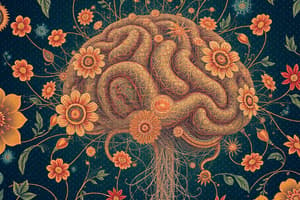Podcast
Questions and Answers
Which area is particularly important for complex actions such as writing?
Which area is particularly important for complex actions such as writing?
- Primary motor cortex (correct)
- Posterior parietal cortex
- Supplementary motor cortex
- Premotor cortex
Which area is important for planning and organizing a rapid sequence of movements?
Which area is important for planning and organizing a rapid sequence of movements?
- Posterior parietal cortex
- Premotor cortex
- Primary motor cortex
- Supplementary motor cortex (correct)
Which area is active during preparations for a movement and somewhat active during the movement itself?
Which area is active during preparations for a movement and somewhat active during the movement itself?
- Primary motor cortex
- Supplementary motor cortex
- Premotor cortex (correct)
- Posterior parietal cortex
Which area is one of the first areas to become active in planning a movement?
Which area is one of the first areas to become active in planning a movement?
Which area is important for making movements, not planning them?
Which area is important for making movements, not planning them?
Which area is stimulated when we imagine movement?
Which area is stimulated when we imagine movement?
Which area is directly connected to the muscles and controls actual muscle movement?
Which area is directly connected to the muscles and controls actual muscle movement?
What is the function of the premotor cortex?
What is the function of the premotor cortex?
What are mirror neurons?
What are mirror neurons?
What are the symptoms of Parkinson's disease?
What are the symptoms of Parkinson's disease?
What is L-Dopa commonly used for?
What is L-Dopa commonly used for?
What are the basal ganglia comprised of?
What are the basal ganglia comprised of?
What is the function of the corticospinal tracts?
What is the function of the corticospinal tracts?
What is the role of the prefrontal cortex?
What is the role of the prefrontal cortex?
What are the limitations of L-Dopa therapy for Parkinson's disease?
What are the limitations of L-Dopa therapy for Parkinson's disease?
Flashcards are hidden until you start studying
Study Notes
Motor Control and Movement
- Primary Motor Cortex: directly connected to muscles, controls actual muscle movement
- Premotor Cortex: active during preparations for a movement and somewhat active during the movement itself, important for planning and organizing a rapid sequence of movements
- Supplementary Motor Area: one of the first areas to become active in planning a movement, important for complex actions such as writing
- Primary Somatosensory Cortex: important for making movements, not planning them
Brain Regions and Functions
- Basal Ganglia: comprised of several structures, involved in movement control and cognition
- Corticospinal Tracts: responsible for transmitting motor signals from the brain to the spinal cord and peripheral nervous system
- Prefrontal Cortex: involved in working memory, decision-making, and planning
Parkinson's Disease
- Symptoms: tremors, rigidity, bradykinesia (slow movement), postural instability
- L-Dopa Therapy: commonly used to treat Parkinson's, helps replenish dopamine in the brain
- Limitations of L-Dopa Therapy: can lead to dyskinesias (involuntary movements) and wearable off-periods
Neurological Concepts
- Mirror Neurons: neurons that fire both when an individual performs an action and when they observe someone else performing the same action, involved in empathy and social cognition
Studying That Suits You
Use AI to generate personalized quizzes and flashcards to suit your learning preferences.




